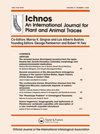外西喀尔巴阡山脉新发现Radhostium carpaticum plika和Říha, 1989的形态(斯洛伐克Biele Karpaty山上白垩世-始新世复理石矿床)
IF 2
4区 地球科学
Q4 PALEONTOLOGY
Ichnos-An International Journal for Plant and Animal Traces
Pub Date : 2022-10-02
DOI:10.1080/10420940.2023.2182301
引用次数: 0
摘要
摘要:本文以一种新发现的相对罕见的痕量化石Radhostium carpaticum为研究对象。这一新发现来自Biele Karpaty单元,保存在斯洛伐克Biele Karpaty山脉上白垩统和始新统Svodnice组浊积岩序列的浊积砂岩底部。该化石的形态学研究是在此基础上和现有的已发表的Radhostium个体进行的。洞穴揭示了一个规则的形态系统,由圆柱形的u形轴(元素)排成一排,由一个水平的洞穴连接。形态学表明,该化石极有可能属于无充填的开放穴居系统。这种形态表明它本质上是一个分叉的洞穴,而不是典型的软体动物痕迹化石的纹路结构。然而,这种形态与已知的形态没有可比性,因此不能可靠地确定痕迹化石的制造者。在阿尔卑斯山脉、喀尔巴阡山脉、亚平宁山脉三个地理区域均有记载。所有的carpaticum标本都出现在上白垩世和古新世浊积岩的深海层序中。因此,在西特提斯相互联系的古地理区域中,Radhostium出现在一个相对狭窄的地层范围内。本文章由计算机程序翻译,如有差异,请以英文原文为准。
Morphology of Radhostium carpaticum Plička and Říha, 1989 in new finds from the Outer Western Carpathians (Upper Cretaceous – Eocene flysch deposits of the Biele Karpaty Mountains, Slovakia)
Abstract A new find of one specimen of the relatively rare trace fossil Radhostium carpaticum is the subject of this morphological study. The new find from the Biele Karpaty Unit, is preserved on the soles of turbiditic sandstones within the Upper Cretaceous and Eocene turbiditic sequence of the Svodnice Formation in the Biele Karpaty Mountains, Slovakia. The morphological study of the trace fossil is based on this and the available published individuals of Radhostium. The burrow reveals a regular morphological system consisting of cylindrical U-shaped shafts (elements) arranged in a row linked by a horizontal burrow. Morphology shows that the trace fossil most likely corresponds to an open burrow system of domichnion without back fill. This morphology indicates that it is essentially a branched burrow and does not represent the chevron structure typical for trace fossils of molluscs. However, this morphology is comparable to no known form, so the producer of the trace fossil cannot be reliably determined. Referred ichnospecies of Radhostium have been recorded in three geographic regions (Alps, Carpathians, Apennines). All specimens of R. carpaticum occur in Upper Cretaceous and Palaeocene turbiditic deep-marine sequences. Thus, Radhostium occurs within a relatively narrow stratigraphic range in interconnected palaeogeographic areas in the Western Tethys.
求助全文
通过发布文献求助,成功后即可免费获取论文全文。
去求助
来源期刊
CiteScore
2.50
自引率
12.50%
发文量
0
审稿时长
>12 weeks
期刊介绍:
The foremost aim of Ichnos is to promote excellence in ichnologic research. Primary emphases center upon the ethologic and ecologic significance of tracemaking organisms; organism-substrate interrelationships; and the role of biogenic processes in environmental reconstruction, sediment dynamics, sequence or event stratigraphy, biogeochemistry, and sedimentary diagenesis. Each contribution rests upon a firm taxonomic foundation, although papers dealing solely with systematics and nomenclature may have less priority than those dealing with conceptual and interpretive aspects of ichnology. Contributions from biologists and geologists are equally welcome.
The format for Ichnos is designed to accommodate several types of manuscripts, including Research Articles (comprehensive articles dealing with original, fundamental research in ichnology), and Short Communications (short, succinct papers treating certain aspects of the history of ichnology, book reviews, news and notes, or invited comments dealing with current or contentious issues). The large page size and two-column format lend flexibility to the design of tables and illustrations. Thorough but timely reviews and rapid publication of manuscripts are integral parts of the process.

 求助内容:
求助内容: 应助结果提醒方式:
应助结果提醒方式:


